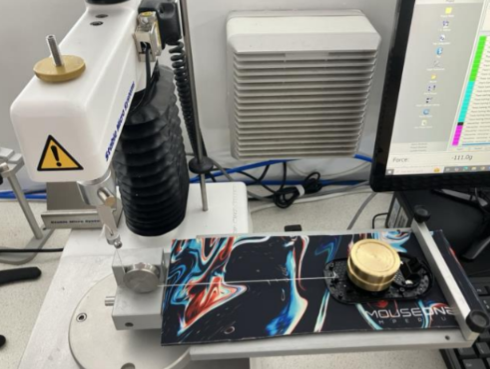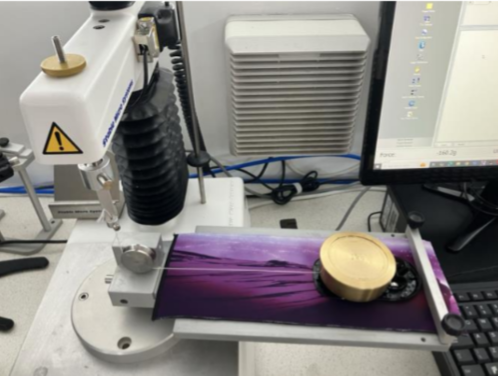Pad Lab
Testing done by Centre for Industrial Rheology.
Full report: J2025-0003 - MouseOne LLC - 08012025.pdf
Keywords:
Stiction force = Static friction force
Friction force = Dynamic friction force
Coefficient of friction = Coefficient of dynamic friction
Please note:
The following are the results of professional lab testing with our Imperium (Squishy) mouse pad and Thasis mouse pad. Although the results show seemingly clear distinctions between the pads, the true differences are more nuanced. There are some intangible factors that make it difficult to pin down exactly how a pad feels. Your personal results may vary depending on the mouse used, pressure applied, humidity, and various other factors, and you’ll have to try the mouse pad in person to feel the true differences. We have included personal comments about the differences between the pads, but these too may be inaccurate depending on your own personal environment and setup.
Equipment and Methods
Testing was performed on a TA.XT texture analyzer fitted with a 500g load cell and a friction rig. The mousepad sample was attached to the friction rig base. The ‘sled’ was comprised of the deconstructed supplied mouse, with the weight placed on the top (see Appendix Two for images). Testing was performed with added weights of 400g and 1kg. The pad sections were cut 90° to each other for X and Y Directions.
Tribology Sled Test
The force was measured throughout the test as the sled was pulled for 100mm at a speed of 2.5mm/s. The mean force from 5s to 30s was quantified and used to calculate the kinetic coefficient of friction as below:
μf = Sliding Force / “Sled” Weight
The stiction force, the peak force found before plateauing, was also quantified for each sample.
All measured were repeated 10 times and the mean results are presented overleaf, all error bars denote ±1 standard deviation.
Below is a table listing all of the friction results obtained through these tests.
Observations (by the lab):
- The results from the testing performed show good repeatability for both samples across all conditions explored, evidenced in the low standard deviations.
- The MouseOne (Imperium - Squishy) sample exhibits a marginally higher coefficient of friction than the Thasis sample, seen when tested at both weights and in both X and Y directions.
- The directions X and Y made minimal difference to the friction force but did show a repeatable difference in terms of stiction force, whereby the values in the Y direction are consistently higher than in the X.
- The MouseOne (Imperium - Squishy) also exhibited a slightly higher Stiction Force (initial force required to initiate movement) to the Thasis sample.
Here are two graphs displaying horizontal friction data for Imperium (Squishy) and Thasis with two different weights applied to the surface.
400g
1kg

Imperium (Squishy) being tested.

Thasis being tested.
Notes by MouseOne:
The following notes were put together by MouseOne.
Imperium (Squishy)
With both lab testing and real-world testing, we found that Imperium (Squishy) is slower than Thasis. We classify Imperium (Squishy) as a control pad due to its high friction. This friction is amplified when greater pressure is applied, due to the Squishy PORON® base.
Thasis
With both lab testing and real-world testing, we found that Thasis is faster than Imperium (Squishy). We classify Thasis as a medium-speed mouse pad due to its faster nature. The friction does increase with added pressure, however, the firm base doesn’t allow for the same ramp-up in friction as the Imperium (Squishy) in dynamic friction.
Imperium - Dynamic friction increases from 114gf to 183gf when weight is increased (to 1kg). This shows an increase of 1.60x when more weight is applied.
Thasis - Dynamic friction increases from 99.3gf to 151gf when weight is increased (to 1kg). This shows an increase of 1.52x when weight is applied.
With this data, we can conclude that the Squishy PORON® base of the Imperium (Squishy) generates greater dynamic friction when extra weight is applied compared to Thasis when extra weight is applied. This is possibly due to the extra contact area the mouse and fingers (that press into the pad) have with the squishy base, leading to increased friction. We will be doing more testing to understand this better.
